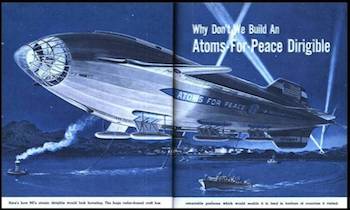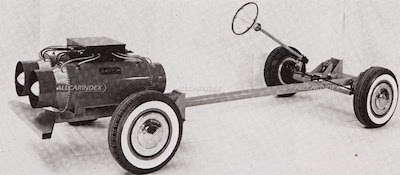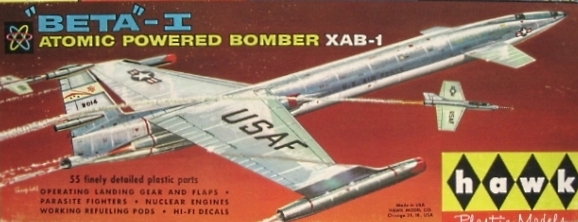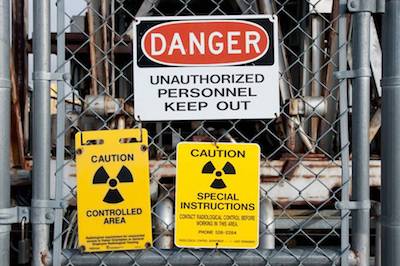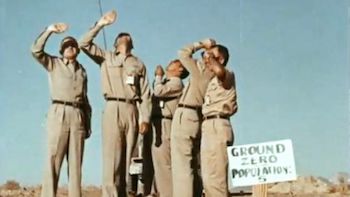“Atomic Follies” by Jim Beall
"Atomic" was the big pre-WWII science fiction "handwavium," with atomic drives powering spaceships, atomic weapons fighting wars, and atomic energy fueling empires. When WWII ended, however, atomic was real.
It had not come easy, nor had it come cheap. The Manhattan Project had consumed resources on an unprecedented scale (1) but, as expensive as it had been, the "a-bombs" it produced led Japan to surrender before the Allies were forced to invade. Given the estimated invasion casualties for Allied and Japanese alike, the Manhattan Project was probably a bargain. (2)
No one knew what would or even could be done with the new handwavium-become-real technology, least of all government bureaucrats who promulgated federal regulations (3) to control it with almost surreal celerity. (4) The public's fascination with anything atomic quickly reached astounding heights.
Atomic Vehicles
Newspapers and magazines became packed with nuclear notions, especially for vehicles. Among the most bizarre was the atomic dirigible!
Figure 1—March 1956 Modern Mechanix
Image courtesy of www.technicacuriosa.com (5)
Atomic locomotives were also a hot item:
Figure 2—Association of American Railroads, 1948
Courtesy of the Association of American Railroads
Unlike the dirigible, the possibility of fuel-free locomotives attracted serious consideration, including a collaboration between the University of Utah and Babcock and Wilcox (called Project X-12). (6) No such locomotive was built, however. For one thing, the study concluded that the required shielding would have weighed more than most conventional locomotives! (One initial calculation estimated 220 tons.) Perhaps learning of Project X-12 (7), the USSR soon initiated a project of their own toward developing nuclear locomotives for the Trans-Siberian Railway. The Soviets appear to have put considerably more resources into the effort than did the U.S. but, in the end, they did not build a nuclear train either. (8)
Meanwhile, Ford had a "better idea"—the "Nucleon" nuclear automobile:
Figure 3—William Clay Ford, Sr., and 3/8 model (9)
Courtesy of www.allcarindex.com
Implicit in the Ford design was that nuclear power plants would soon be miniaturized enough to fit comfortably into the trunk of a car. Sadly, this did not happen in real life, despite A.E. Van Vogt's having already fit one (in his novel Slan, serialized in Astounding in 1940) into the hero's wedding band!
French car designers also proposed an atomic-powered automobile, named the Arbel:
Figure 4—1958 Arbel/Symetric Advertisement
Courtesy of www.allcarindex.com (10)
The French design avoided the Nucleon's miniaturization problem by not using a nuclear reactor and steam plant. Instead, the internal power source of the Arbel was to look like this:
Figure 5—1958 Arbel/Symetric Power Source
Courtesy of www.allcarindex.com
Here is a close-up view of the power source from another angle:
Figure 6—Arbel/Symetric Power Source
Courtesy of www.allcarindex.com
The assembly in the rear of the chassis was the "genestatom"—a 40-KW nuclear thermal generator using two radioactive cartridges filled with none other than nuclear waste! Consider your plight if you owned one, had just been in a car accident, and were on the phone with your insurance agent. The police have abruptly fled from the yellow-taped boundary and HAZ-MAT vans are rolling in, sirens blaring. You're worried, and for good reason. Would your coverage include the costs of evacuating half of the city for clean-up?
Of course, science fiction contained what the public truly wanted:
Figure 7—Tom Swift and His Triphibian Atomicar
Author's collection
Sadly, we still don't have it.
The Tom Swift series is also related to another Folly: Tom Swift and His Atomic Earth Blaster (1954). The fictional invention was a nuclear-powered drilling machine and, as preposterous as this might seem, Los Alamos would patent a similar design eighteen years later: Patent Nos. 3,693,731 and 3,885,832. The author has always wondered if some Los Alamos scientist had read the Tom Swift book as a youth and, upon reaching adulthood, could not resist designing and patenting one like it. (11) Compare the images below:
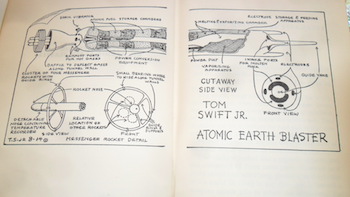 |
 |
| Figure 8—Tom Swift's atomic drill Author's collection |
Figure 9—Los Alamos' atomic drill Public Domain: Patent 3,693,731 |
Atomic Toys
Toy makers also went atomic crazy, with games, models, comics, and more. Children fought it out with atomic handguns, dropped atomic bombs for scores, and the Lone Ranger even had an atomic bomb ring!
 |
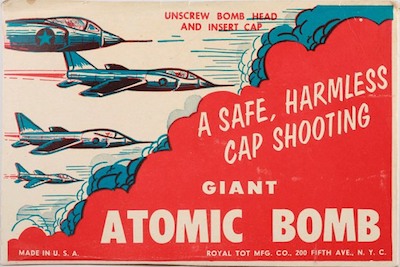 |
| Figure 10—Atomic Toy Pistols (12) Courtesy of Oak Ridge Associated Universities (ORAU) Health Physics Historical Instrumentation Museum Collection |
Figure 11—Atomic Bomb Toy Courtesy of Wikipedia, and The Children's Museum of Indianapolis |
 |
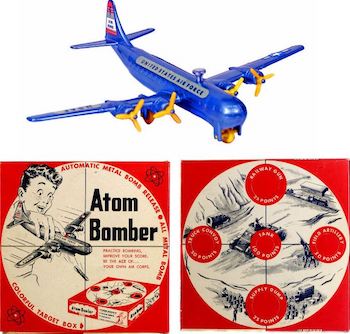 |
| Figure 12—Lone Ranger Atomic Bomb Ring Courtesy of Roger Russell (13) |
Figure 13—Atom Bomber Game Courtesy of Hake's Americana & Collectibles (14) |
The one toy that deserves the title of "Atomic Folly," however, is the one below:
Figure 14—Gilbert Atomic Energy Lab
Courtesy of Wikipedia
The Gilbert Atomic Energy Lab allowed owners to conduct working experiments, such as watching radioactive particle tracks in the included cloud chamber. What made it all possible were the contents of the four carefully packed jars in the upper left: four different radioactive isotopes! The kit also came with a "Radioactive Source Replacement" coupon for when the original sources decayed below usefulness. The "Lab" was available only for about one year (1950-1). Perhaps the company (or their lawyers) developed second thoughts about putting vials of radioactive isotopes in the hands of children. (15)
The Atomic Jet
Almost lost in the noise, the U.S. government released that work had begun on atomic jet engines. (16) The announcement went largely unremarked upon at the time, but the 1950s interest in all matters atomic soon brought nuclear aircraft speculation into high visibility. One of the earliest to address the possibility was Gerald Wendt's (17) October 1951 article in Popular Science, "A Scientist Previews the First Atomic Airplane." In it, Wendt predicted the first atomic plane would contain "a red-hot boiler and turbine engines geared to [wing-mounted] propellers." In other words, it would be an atomic propeller plane! Perhaps more technically serious was the RAF Flying Review announcement (October 1954) that not only were GE and Pratt and Whitney working on nuclear jet engines for the U.S. Air Force, but also that Harwell was doing likewise in Britain, with the magazine article containing portions of a design study.
Nonetheless, no atomic plane had yet appeared when the magazine Aviation Week related the alarming news (December 1958) that the Soviets were already flight testing a nuclear jet bomber. In fact, the article stated that the plane "had been completed six months previously," had been "flying in the Moscow area for at least two months," and had been observed in flight by observers from both Communist and non-Communist countries. Perhaps fearing a Sputnik reprise, reports of Western nuclear planes soon appeared in other magazines. Air Progress and Science and Mechanics were just two of the periodicals that discussed how far advanced were the ongoing British and U.S. atomic plane efforts.
Really cool toys and model kits began to appear of futuristic jet bombers, including:
Figure 15—BETA-1 Model (Also called XAB-1) 1959
Author's Collection
Still, however, no atomic plane appeared.
Then, on March 28, 1961, President Kennedy issued a statement cancelling the entire U.S. atomic jet program! The summary line was: "Nearly 15 years and about $1 billion have been devoted to the attempted development of a nuclear-powered aircraft; but the possibility of achieving a militarily useful aircraft in the foreseeable future is still very remote."
At the time of cancellation, the U.S. had developed and ground tested nuclear jet engines of two different designs and flight tested the nuclear power plant (but not powered the plane with it) of one of them. Both designs performed as the scientists and engineers had predicted. (18) The engines, in particular, produced all the predicted thrust in ground tests and further improvements were in the offing.
If everything was working, what had gone wrong? Why terminate it?
One cited factor was that ICBM technology had appeared and filled the atomic bomber's original strategic mission of a delivery system for nuclear weapons with the range to strike anywhere on the planet. A subsequent Comptroller of the United States report (19) cited a variety of mismanagement contributors, including frequent changes in program objectives, deficiencies in administration, and absence of stability. (20)
There is more to the story, however, and perhaps the best way to explain it is to show two of the atomic jet engines themselves: Heat Transfer Reactor Experiment (HTRE) Number One and Three. They are both on public display at the end of a simple, nondescript parking lot in Arco, Idaho, not far from where they were tested. The first clue is the winter shot below:
Figure 16—HTRE-1 and 3 (on right)
Courtesy of Wikipedia
The yellow object on the left is the RR engine used to move the atomic engines (which are skid-mounted on rails). Its unusual shape is from the heavy shielding required to protect the operator from the enormous residual radiation fields from unshielded nuclear reactors after power operations. One of the author's coworkers had been associated with the project and witnessed some of the test runs. He related that the engines did indeed put out all the desired thrust, but that they were so radioactive during operation that an atomic plane's airfield would need to be evacuated for takeoffs and landings. He asserted that the plane would not even need weapons, as simply flying low over enemy personnel would kill them!
Visitors can see the engines, but cannot touch them, as they are within securely fenced enclosures clearly marked with the warning signs below:
Figure 17—Still Radioactive
Author's Collection
Nearly sixty years after last operation, even with the nuclear fuel removed, they are still radioactive!
It is worth noting that the radiation difficulties inherent in operating (and landing) planes with such engines were accurately featured in the science fiction novel Steam Bird, by Hilbert Schenck:
Figure 18—Steam Bird, by Hilbert Schenck
Author's Collection, Courtesy of David Lynn Mills
In the story, an atomic bomber (with engines much like the ones within the fences shown above) is inadvertently scrambled as part of escalation during a minor crisis. The crisis soon subsides, but trying to figure out how and where to land the plane safely turns out to be a far greater problem!
As for the Soviet jet bomber that Aviation Week had reported in 1958, it turned out to have been a hoax, and the bomber (M-50, NATO named "Bounder") was never atomic powered at all. The USSR did have an atomic jet program, several in fact. The first appears to have begun in earnest in mid-1955, almost exactly six months after the RAF Flying Review article cited above, leading the author to wonder if that had been a contributor. In any case, the Soviets put a lot of resources into the efforts but got no further technologically than the U.S. had before abandoning the projects years after the US. Visitors can see the "Bounder" at the open air portion of the Central Air Force Museum, Monino Airfield, near Moscow. (21)
Perhaps in an effort to turn the lethal radiation "bug into a feature," the U.S. adopted the atomic jet engine technologies for Project Pluto, which was a new type of weapon: the "Supersonic Low Altitude Missile" (SLAM). The SLAM was to be a massive drone, launched with a conventional booster (avoiding radiation problems at the launch site) with the nuclear ramjet ("Tory") igniting upon reaching suitable altitude and velocity. The 500—600 MW nuclear reactor (many times more powerful than the jets were to be with humans aboard) would then give the ramjet missile the ability to loiter indefinitely (22) over ocean or the Arctic Circle, then drop to low altitude upon command and head for its target. Tory went through millions of dollars and multiple prototypes but performed as designed during power tests. (23)
 |
 |
Figures 19 and 20—Project Pluto Tory IIC Engine
Courtesy of Wikipedia
The SLAM was to be quite large, and hold as many as twenty-six nuclear bombs in its internal bay. The intended "mission" was for it accelerate to Mach 3+ as it approached enemy airspace, drop its bombs at designated targets, then continue to cruise along indefinitely, crisscrossing enemy territory at very low altitude, causing devastating shock waves even as it exposed all below to its unshielded reactor core. Eventually it would crash, distributing highly radioactive plutonium liberally about the impact site.
On July 1, 1964, seven and a half years after Project Pluto was initiated, and forty days after the atomic engine's triumphant sustained full power test, the program was terminated.
The official reason was, again, that ICBMs had assumed the original intended role. Another cited reason, however, was that fielding the system would likely compel the USSR to match it, and apparently no one wanted that! (24) Nonetheless, the U.S. expended a lot of money and other resources (for example, Chance Vought alone had one hundred seventy-seven scientists and engineers full-time on the project until the cancellation announcement) on what the Department of Defense called "a model technology program" and then terminated it because it produced exactly what had been requested. (25)
Atomic Weapons
After WWII ended, one thing the U.S. knew for sure was how to make atomic bombs ("A-Bombs"). There was great room for improvement in power and little empirical data on effects, so the U.S. conducted multiple series of A-Bomb tests to address both issues. The series "Desert Rock" (1951—1955) remains one of the worst Atomic Follies of all, as tens of thousands of servicemen watched as (air-dropped—what if pilot error?) nuclear weapons were detonated a few miles away, and then were ordered to get out of their trenches and march closer. The worst of the Folly was that none of the senior officers, officials, or physicists considered that airborne radioactive particles might give low external readings but would be deadly in the long term due to inhalation and lodgment in lungs. (26)
Sadly, Operation Desert Rock was far from the only A-Bomb Folly and the image below of the red-suited man standing in a cavern belongs to the next one.
Figure 21—Project Gnome
Public Domain, Source: Los Alamos National Laboratory
The U.S. decided to explore possible peaceful uses of A-Bombs with "Operation Plowshare" (as in turning swords into plowshares). The first of these efforts was Project Gnome. An A-Bomb (3.1 kiloton) was detonated about 1,200 feet underground in a halite (rock salt) deposit. The stated intent was to study the possibilities of harnessing the heat and harvesting certain isotopes from the melted salt, and using the resulting underground void as a storage chamber (possibly for radioactive waste).
International press and dignitaries had been formally invited and many were on hand for the event, but things did not go quite as planned. Billed as a demonstration of control and safety, the detonation blew out the tunnel plugs and vented radioactive gas and steam in plain view (and potentially contaminating the guests—so much for safe and controlled!). In situ examination required a second tunnel be drilled, as the first was now heavily contaminated. The man in Figure 21 above is standing within the subterranean cavern created by the blast. Although they waited until decay had reduced ambient radiation levels, note that (like the soldiers earlier in Operation Desert Rock) he is not wearing respiratory equipment.
As for the intended purposes of Gnome, it turned out that multi-kiloton explosions just happen to grossly shatter strata, burying the melted salt and isotopes under massive piles of rubble from the walls and overhead (hence the lower than expected radiation levels in the cavern). The cavern was used as a storage chamber for radioactive waste, however, as that is where they packed most of the surface soils that had been contaminated by the ejected gases and steam. All that remains today of Gnome is a non-descript concrete marker in the desert:
Figure 22—Gnome Marker
Courtesy of Wikipedia
Operation Plowshare then conducted a series of nuclear detonations to investigate the feasibility of A-Bombs as excavation tools for railroad cuts or even a canal. After making a few large holes and trenches with considerable radioactive releases to the atmosphere, someone eventually did the math concerning the fallout that would result from the required number of explosions to do anything useful and all such efforts were abandoned. (27)
Many today decry hydraulic fracking due to various environmental concerns, including potential ground water contamination from injection chemicals. The first "Gas Buggy" Operation Plowshare test was carried out by the Lawrence Radiation Laboratory and the El Paso Natural Gas Company, with funding from the Atomic Energy Commission. Its purpose: A-Bomb fracking! Two additional detonations occurred with different petrochemical company partners and gas was produced afterwards at all three sites. The practice was never adopted, though, because (hardly surprising) the gas extracted was radioactive! (28)
Operation Plowshare ended without identifying any clear or conclusive peaceful uses for blowing things up with nuclear weapons, but the official project report did intimate there just might be some if only things like test bans and radioactivity releases fears could be dealt with. (29)
The next Atomic Folly involves the men below in Figure 22. What they looking at?
Figure 23—Genie Test (Operation Plumbbob)
Courtesy of Peter Kuran, Visual Concept Engineering Films
Another part of the 1950s was the Cold War threats posed by the USSR. Once the Soviets had conducted their own A-Bomb tests, the growing capabilities of enemy long-range bombers became one such threat. The U.S. investigated several avenues of defense, including fitting A-Bomb warheads onto air-to-air missiles. When word that one such missile (Genie) was scheduled for public test, five officers volunteered to stand directly below where the nuclear detonation was to occur at an altitude of twelve to eighteen thousand feet (sources differ)! Not only did they do precisely that (July 19, 1957), but they also video-taped the entire event. (30)
Another major aspect of the Cold War was the development of ever larger nuclear weapons. The A-Bomb (31) eventually became succeeded as the most fearsome weapon on Earth by the thermo-nuclear hydrogen bomb ("H-Bomb"). These new devices were so powerful that the "kilotons" (TNT equivalent) rating of the A-Bombs had to be replaced by "megatons" for the H-Bombs.
Where A-Bombs use only the nuclear fission of uranium and/or plutonium when detonating, H-Bombs use a fission bomb to produce a second and far greater energy release by causing a fusion nuclear event. In simple terms, the X rays and neutrons from the fission event cause fusion of the hydrogen isotopes of deuterium and tritium. Some of the tritium (32) fused would be created during the event itself by breaking down stable lithium into tritium. The U.S. tested the first H-Bomb (Ivy Mike) on November 1, 1952, with a yield of 10.4 megatons
On the face of it, the second H-Bomb test, Castle Bravo, was a complete success. It went off when it was supposed to and remains the largest nuclear device set off by the US. Ivy Mike had used cryogenics (hardly suitable for a deployed weapon) and expensive, highly-purified Lithium-6, such that the device was as much a building as a bomb. This second device was smaller and cheaper, in part because cryogenics were avoided and the lithium was only partly enriched. The far more common isotope, Lithium-7, comprised sixty percent of the lithium used and was not expected to contribute to the yield. (33) Thus, the physicists included only the mass of Lithium-6 in their blast calculations.
The first indication that all the physicists had been wrong was when the fireball from the supposed six megaton device was observed not to be the expected two miles wide, but four and a half! Observers stationed on a nearby island were the first to react, and they did so by quickly abandoning their posts for the shelter in the basement. They survived, but the structure above them and all the base structures on the nearby atoll were damaged beyond recovery, and many instruments designed to record the event were vaporized.
Post-test calculations (34) concluded that the actual blast had been about fifteen megatons, or two and a half times expected. Fifteen inhabited islands had to be evacuated. Fallout effects spread far and wide, with cancers and birth defects reported for years. Crewmen aboard a Japanese fishing boat outside the official danger zone (but well within the actual one) came down with radiation sickness. The U.S. would pay $15.3 million to Japan as reparations. (35)
Our final Atomic Folly has nothing to do with the nuclear device involved at all. The blast yield was exactly as anticipated. The delivery system also functioned precisely as designed. Instead, the Folly aspect was the underlying concept of the weapons delivery system itself: The Atomic Cannon!
One can almost visualize a senior Cold War Pentagon meeting. The U.S. military had atomic bombs, missiles, and torpedoes. Obviously, all that was lacking, then, were atomic cannons!
Once identified, this military preparedness deficiency was soon rectified. The recent U.S. Army experiences with the effective German rail gun "Anzio Annie" (36) led the designers to begin with that shell size (280 mm, or about 11-inch). Physicists were able to miniaturize Hiroshima yield size devices enough to fit into the shells, and soon the U.S. Army possessed "Atomic Annie" with large fore-and-aft trucks ("prime movers") for on-road and off-road mobility. A total of twenty were built and deployed. (37)
 |
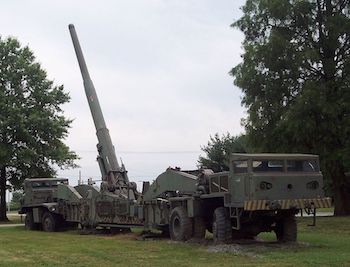 |
| Figure 24—"Anzio Annie" Courtesy of Wikipedia |
Figure 25—"Atomic Annie" Public Domain, Source: U.S. Army |
So, if the cannon and the shell both worked as designed, how is it an Atomic Folly?
The answer is implicit in the image below from the one-time Atomic Annie fired an atomic shell. (38)
Figure 26—Nuclear Artillery Test—Grable Event
Public Domain, Source: DOE
The shell flew seven miles, and the maximum effective range was a bit over twice that. Suppose that the enemy is that close and in such force that nuclear weapons are needed to deal with the threat. How can driving around in something resembling a monster hooking-ladder fire engine with atomic weapons aboard be a good idea?
In truth, nearly all the A-Bomb and H-Bomb tests before 1963 were Atomic Follies because they ejected large quantities of radioactive fallout into the atmosphere. That year, most nuclear powers signed a partial ban on nuclear weapons testing, limiting such detonations to underground. (39) Since then, the amount of radioactive material in the atmosphere has slowly decreased, but remains detectable. In fact, the best sources for steel used in applications requiring near-zero radioactive emissions (like medical scanners) are from recycling steel made before the first atomic bomb, with the most famous source the German dreadnoughts scuttled at Scapa Flow in 1919.
In closing, the abrupt reality of atomic technology caught everyone (except the science fiction community) completely by surprise. In hindsight, it was perfectly predictable that government officials would be the first to act, and try their bureaucratic best to tie it up with regulations. Equally predictable was that the military would weaponize it in every way imaginable, and then strain to come up with new imaginings. It's also unsurprising that non-scientific folk would react to the public's fascination by attempting to force fit "atomic" into all sorts of bizarre applications, even dirigibles and family cars. As for making toys with new kinds of guns, rockets, and other stuff, that was always going to happen.
No, the true Atomic Follies were when those who should have known better kept blowing things up with bigger and bigger devices, ejecting tons of highly radioactive materials into the Earth's biosphere and, in the process, exposing innocents. First were obedient servicemen and then islanders and fishermen, but the effects were global and linger still.
FOOTNOTES
1) Spread out among about thirty sites, Oak Ridge and Hanford alone occupied about three hundred square miles of real estate and contained about a thousand buildings in which several thousand top scientists and over a hundred thousand workers toiled during the Project's five years.
2) The U.S. manufactured five hundred thousand Purple Heart medals as part of invasion preparation. The U.S. kept them in inventory after WWII and the Purple Heart received by the author's son in Iraq was one of those same medals. That is, all the Purple Hearts awarded in the following sixty years had been expected to be issued to the actual recipients' uncles, fathers, and grandfathers, many posthumously.
3) The regulation (Section 2181 TITLE 42 U.S. Code of Federal Regulations) remains in force today. The phrasings include: "Any person who makes any invention . . . useful in utilization of . . . atomic energy, shall file with the Commission a report . . ." Another one: "Any invention or discovery . . . shall be . . . the property of the Commission." Soothingly, it also promises that any previously granted patents will be subject to "just compensation." Thus, should the reader invent a nuclear space drive, remember to file a report with the federal government who, thus alerted, may declare it federal property. The same would apply to any SF author's inventor character!
4) The regulation was issued on August 1, 1946. Given the lead time from initial drafting to approval and formal publication in the Federal Register, regulators may have already been working on it as the Enola Gay took off to drop the first A-Bomb on Hiroshima less than one year earlier.
5) The complete article by Frank Tinsley (with additional images) can be found on-line here: http://blog.modernmechanix.com/why-dont-we-build-an-atoms-for-peace-dirigible/
The host site—www.technicacuriosa.com/—is home to a wealth of unusual, historical documents and images.
6) See U.S. Patent 3127321.
7) It had been featured in an article in Life, June 21, 1954, including drawings!
8) For one thing, much of the railway—total length 5,772 miles—would have had to be re-tracked and all the bridges replaced.
9) The pictured model is currently housed at the Ford Museum in Dearborn, Michigan.
10) This image and the following two images of the nuclear 1958 Arbel/Symetric can be found, along with many others, at: http://www.allcarindex.com/main-index/car-make-details/France-Arbel--Symetric/
11) For more information, see: https://www.bibliotecapleyades.net/archivos_pdf/NSTMs.pdf
12) For more atomic toys and other related items, visit: https://www.orau.org/ptp/collection/atomictoys/atomictoys.htm
13) Image courtesy of Roger Russell. For more images and background, see: http://www.roger-russell.com/radioactive/radioactive.htm#ranger
14) Hakes Americana and Collectibles sells many such items. The Atom Bomber game last went for $285.99! See: https://www.hakes.com/Auction/ItemDetail/2014/Atom-Bomber-Toy-Plane-WAutomatic-Bomb-Release-In-Original-Box
15) Originally fifty dollars, the author recently considered purchasing one for demonstration purposes, but was dissuaded by the then-going price of over seven thousand dollars!
16) The announcement was public in May, 1946, and the U.S. Army began the Nuclear Energy for the Propulsion of Aircraft (NEPA) project that same month to develop a nuclear propulsion system for aircraft. NEPA would be handed off to the Atomic Energy Commission in 1951 and renamed the Aircraft Nuclear Propulsion program.
17) Dr. Wendt had already authored The Atomic Age Opens (1945) and Atomic Energy and the Hydrogen Bomb (1951) and would go on to publish at least three more nuclear-related titles.
18) A good overview of the atomic engine program, complete with wonderful images and tables showing how closely performance matched predictions, can be found at: http://www.holosgen.com/about-us-1-2/
19) See: https://fas.org/nuke/space/anp-gao1963.pdf
20) In contrast, Hyman G. Rickover took over the incredibly successful USN nuclear propulsion program near its beginning and stayed at its head for over thirty years.
21) After the fall of the Iron Curtain and the USSR, certain documents indicated that the Soviets had, in turn, become alarmed at the inaccurate reports of significant U.S. progress in atomic bombers. So alarmed, in fact, that they may even have flown a partly nuclear-powered bomber using inadequate shielding simply to get it airborne, but irradiated the crews and killed several in the process. See: https://www.youtube.com/watch?v=_cnFtYuqXX8
22) Ramjet missiles were already well understood. For example, the USN Talos ramjet missile had been deployed since 1959 and had a maximum speed of Mach 2.5. Talos used a solid fuel booster to boost it to ramjet speeds. The author served aboard USS Long Beach (CGN-9), which had used Talos missiles to shoot down two enemy planes in 1968 at ranges over 60 miles. Talos missiles were not nuclear fueled, however, and were limited to a maximum range of "only" 130 miles.
23) Designing, operating, and studying a ~500 MW unshielded reactor provided many technical challenges. For one thing, the high operating temperatures (needed for "ram" operations) required the use of ceramic fuel elements instead of metal, ~465,000 of them! They were manufactured by a division of Coors, better known now for a different product. Testing the ramjet offered even more challenges. One of these was the construction of a "field" of twenty-five miles of oil drilling casings to hold the million pounds of highly compressed air needed to simulate ram operation, which it did for about five minutes on May 20, 1964.
24) Or, in the official phrasing offered by the Department of Defense and the State Department, the system was “too provocative.”
25) As a postscript to Project Pluto, Russian President Vladimir Putin announced on March 1, 2018, that the Russians had recently developed and tested a nuclear-powered cruise missile.
26) The USSR, upon learning of Desert Rock, would conduct their own similar Folly (Totskoye or "Snowball"), with about twice the kilotons and twice the servicemen. The Soviets did not merely march their soldiers closer, they bombed and shelled the cratered zone first, thus maximizing airborne radioactive particles.
27) The Soviets learned of the U.S. tests and conducted their own using perhaps twice the kilotons. One resulting crater filled with water and is now called "Atomic Lake." It remains somewhat radioactive, and is favorite site for locals to water cattle and pick mushrooms.
28) Hydraulic fracking activities have come increasingly closer to the Gas Buggy test site boundaries. Frackers have petitioned the U.S. government to let them extract within them, arguing that by now the gas has probably decayed to below detectability.
29) An official recounting of Operation Plowshare, with its conclusions in carefully coached and formal phrasings, can be read here: https://www.hsdl.org/?view&did=721172
30) AtomCentral.com is a premier source of visual material on nuclear tests and related material in the years following World War II. The specific video can be found here: https://www.youtube.com/watch?v=1VZ7FQHTaR4
31) The largest "pure fission" A-Bomb ever detonated was the 500 kiloton yield "Ivy King" on November 16, 1952.
32) Tritium is a radioactive isotope of hydrogen and thus decays over time. Thus, not only does it not store well for long periods, but also the changes in concentration from the decay also change the physics of any bomb it is in.
33) That is, the physicists had concluded that the nuclear reactions taking place during the fission and fusion events in the detonation would not make tritium from Lithium-7 that could undergo fusion during the event.
34) The physics was recalculated, and the extra yield was henceforth labeled the "tritium bonus."
35) A major part of the "deal" was that Japan would not add the affected fishermen to the "Hibakusha" list of those who had survived Hiroshima and Nagasaki.
36) One fine recounting of those experiences can be found at: http://samilitaryhistory.org/vol133lw.html
37) The history of Atomic Annie origins and deployments, complete with discussions of the inter-service politics and deployment difficulties, can be found here: https://www.globalsecurity.org/military/systems/ground/m65.htm
Additionally, a promotional video, including non-atomic firings, can be viewed here: https://www.youtube.com/watch?v=hZ1Oi15044c
38) The atomic firing test can be viewed here: https://www.youtube.com/watch?v=46GBjlUOROY
39) China and France are among the non-signatories, with China alone conducting about twenty-three atmospheric tests after the 1963 treaty. Also, several underground tests by signatories ended up venting radioactive material, similar to what happened at Gnome.
Copyright © 2018 Jim Beall
Jim Beall (BS-Math, MBA, PE) has been a nuclear engineer for over forty years, a war gamer for over fifty, and an avid reader of science fiction for even longer. His experience in nuclear engineering and power systems began as a naval officer. Experience after the USN includes design, construction, inspection, enforcement, and assessment with a nuclear utility, an architect engineering firm, and the U.S. Nuclear Regulatory Commission (USNRC).


